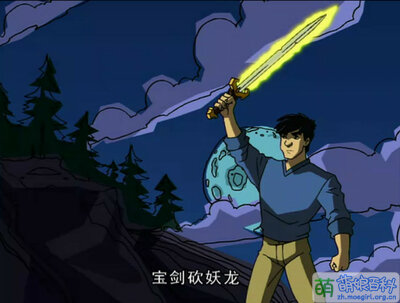Moegirlpedia would welcome your assistance in improving this article☆Kira~
As you read this article, you're welcome to participate in editing this page. Before editing, please read the wiki quickstart, editing guidelines and retrieve relevant information. We wish you a good time on Moegirlpedia. |
 | |
| Base Info | |
| Moe Point | Jian (剑) |
|---|---|
| Moe Point Synonyms | Bao Jian (宝剑) |
| Type | Weapon |
| Related Moe Points | sword, katana, dao |
Jian is a generic term for all types of Chinese double-edged swords, and a common item in ACG works.
Overview
The traditional Chinese concept of weapons holds that a jian is a long straight, double-edged sword with a slender, pointed end, with a short handle, a sharp edge, and a small handguard, distinguished from the dao (which are single-edged).
As one of the "four weapons" in ancient China (dao, jian, jiang and gun), the jian is revered as the "king of a hundred weapons". The jian is usually held with one hand, attacking by swinging it and stabbing, a sword and shield combination was also used in the Bronze Age. There is also a two-sword tactic in martial arts, in which the swordsman holds a jian in each hand against the enemy, and the guard and hilt of the two swords have been shaped, it can be inserted in a wider scabbard for carrying.
History
Pre-Qin and Qin dynasties
The earliest jian can be traced back to the Chunqiu period, at this time, the wearing of the jian had become part of the custom of the scholars and nobles. Due to the limited strength of bronze, short jian were predominant in this period, the main method of use was the sword and shield combination. Only a small percentage of long jian were made, for example, the sword that Qin Shi-huang carried on his back.
Han dynasties
During the Han dynasty, mass production of steel became possible, and bronze swords were quickly replaced by iron swords.
During the two Han dynasties, a surge in jian took place, evolving the cross-guard, a two-hand extra-long sword with a D-shaped gauntlet of over more than 1.5 meters long, and a large bowl guard similar to the rapier. These changes were made due to the prevalence of private fights among the people at that time.
On the other hand, the jian disappeared from the frontlines of war and turned into a defense weapon and accessory. Replacing is position was the cheaper dao.
After the Eastern Han Dynasty
Afterwards, the famous fancy jian forms became extinct. The mainstream jian had become one-handed swords with a small guard, like the small European swords used in that time. Usually no sidearm or shield is used.
Broadswords were once popular from the Five Dynasties to the Southern Song dynasty, they can be seen as double-edged machetes. During the Ming dynasty, a few jian imitated the European style due to learning from the West, and rare bent handguards appeared.
Appearing in ACG works
In the pre-Qin era, the jian still had military overtones, but as mentioned earlier, with the rise of weapons such as the dao since the Western Han dynasty, the jian gradually lost its military tone. In turn, they have been used by famous swordsmen, chivalry, as well as novelists and opera actors attached to the chivalry, gaining fantastical and divine overtones.
Nowadays, the jian is said to be common in martial arts ACG works, and it would also be used in works with fantasy elements to ward off evil spirits, exorcise, etc. Or even simply become a magic weapon, and give birth to a soul of its own.
Some of the more classic uses include the "royal sword technique" or "royal sword flight", or an image of a cloaked Taoist priest in white robes chanting on a high altar while holding the sword. Relative to the nature of its weapons, the jian is more like a "wand of steel with an open blade". Of course, the priest doesn't use a real sword, daomujian and jinqianjian are also often used as "ghost repellers", but that would have to be covered in a separate article.

Due to the role of the jian as a manifestation of the character's social status, it has also been associated from time to time with royalty, other times, it has been linked to a senior officer. At the same time, the jian is often associated with the character's positive traits, such as righteousness, frankness, and gentlemanly manners.
Characters with this moe point
- Zhao Ling'er (Sword and Fairy)
- Huang Lee (Grand Theft Auto: Chinatown Wars)
- Captain Zao, Oswald Oppenheimer (Fallout (series))
- Li Syaoran (Cardcaptor Sakura) (Used as a staff)